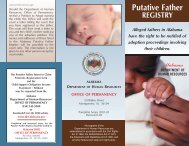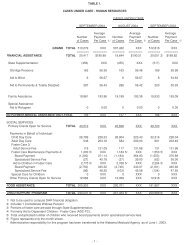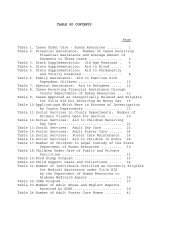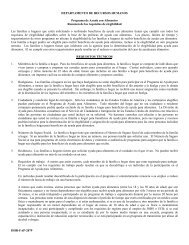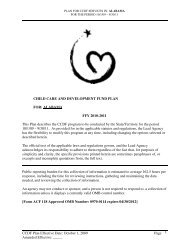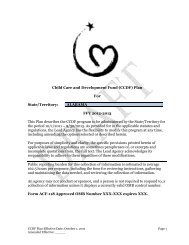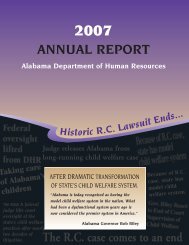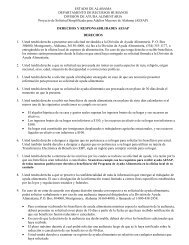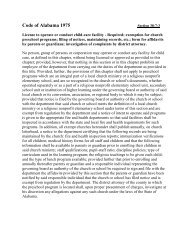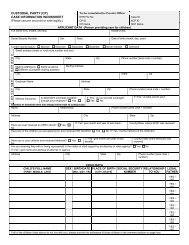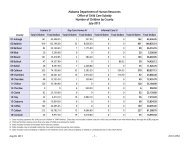DHR’s response to potential foster andadoptive parents improved by participationin “Answering the Call” campaign.Adoption services accentuatedFor some children who come into care, reunificationwith their families is not the permanent plan. In caseswhere parental rights are terminated, the children areavailable for adoption. The department placed 315children with adoptive families in FY 20<strong>04</strong>. The statereceived an incentive award from HHS for improvedperformance in adoption placements. At the end <strong>of</strong>the fiscal year, 284 children in DHR’s permanent custodyhad no identified adoption resource.The department’s Adoption Policy Manual was revisedand released, and training was provided to countystaff in August 20<strong>04</strong>. AdoptUSKids, which featuresphotos <strong>of</strong> children awaiting permanent homes, startedthe “Answering the Call” marketing campaign. As part<strong>of</strong> the effort, AdoptUSKids financed a RecruitmentResponse Team (RRT) in each state. In <strong>Alabama</strong>, theteam members included DHR and the Children’s AidSociety. Participation in the “Answering the Call” campaignimproved DHR’s responsiveness to potentialfoster and adoptive parents.DHR gets two new deputiesTwo veteran employees were appointed deputy commissionersduring FY 20<strong>04</strong>. Carolyn B. Lapsley was appointed DeputyCommissioner for Children and Family Services. Ms. Lapsleybrought twenty-six years <strong>of</strong> experience to the position,including twenty-three years in child welfare services. Forthree years, she was director <strong>of</strong> DHR’s Child SupportEnforcement Division. Prior to being appointed DeputyCommissioner for Children and Family Services, Ms. Lapsleyserved as R.C. Coordinator during the overhaul <strong>of</strong> the state’schild welfare system. She became the agency’s first African-American deputy commissioner.Belyn Richardson was appointed Deputy Commissioner forQuality Assurance and Information Services, marking hersecond stint with the agency. Richardson had retired fromDHR before she was named Assistant Director <strong>of</strong> the state<strong>Department</strong> <strong>of</strong> Children’s Affairs. She served in that postuntil she rejoined DHR. The appointments <strong>of</strong> Lapsley andRichardson gave the department a total <strong>of</strong> five deputy commissioners.The other deputy commissioners are P. L. Corley(Fiscal and Administrative Services), Terrie Reid (Family<strong>Resources</strong>), and James Slaughter (Field Administration).Foster Parent Bill <strong>of</strong> Rights becomes lawIn April 20<strong>04</strong>, Governor Bob Riley signed the FosterParent Bill <strong>of</strong> Rights into law. Commissioner PageWalley supported the bill, which passed with bipartisansupport among state lawmakers. Senator SundraEscott (D-Birmingham) and Representative MacGipson (R-Prattville) co-sponsored the legislation. Thelaw gave foster parents specific rights, includingaccess to certain information, training and services.CHILD SUPPORT ENFORCEMENTA record $262 million in child support was collectedstatewide during FY 20<strong>04</strong>, eclipsing the $256 millioncollected in the previous year. Support collected innon-welfare cases makes it less likely that the familywill have to go on government assistance. In welfarecases, child support collections help recoup the cost<strong>of</strong> providing government assistance to the noncustodialparent’s dependent children. The child support programserved more than 185,000 dependent children inFY 20<strong>04</strong>.Increased use <strong>of</strong> electronic communicationIn November 2003, child support payment informationbecame available online to both custodial and noncustodialparents. It was anticipated that the availability<strong>of</strong> the information online would reduce the volume <strong>of</strong>calls to the agency’s toll free hotline.During the year, DHR began handling consumer creditcomplaints electronically rather than by mail. Thecomplaints usually come from noncustodial parentswho discover that delinquent child support paymentshave an adverse impact on their credit rating.Transmitting information to credit bureaus electronicallywas expected to simplify the process for resolvingthe complaints. It was also expected to give countystaff more time for tasks related to collecting supporton behalf <strong>of</strong> dependent children.MILLIONS OFDOLLARS30025020015010050YEARCHILD SUPPORT COLLECTION$256,000,000.00 $262,000,000.00$240,000,000.00 ●●$229,000,000.00 ●$219,000,000.00 ●●2000 2001 2002 2003 20<strong>04</strong>6
FOOD ASSISTANCEStill a nutritional safety netFollowing a national trend, there was an increase inthe average number <strong>of</strong> <strong>Alabama</strong> households receivingfood stamps each month. An average <strong>of</strong> 197,237 familiesreceived food stamps monthly, compared to amonthly average <strong>of</strong> 185,028 in the previous year. Thisrepresented a 6.5% increase in participation. Familiesreceived more than $506 million in food stamp benefits,compared to the $466 million in benefits providedthe year before. Households received a monthly average<strong>of</strong> $216.58 in benefits in FY 20<strong>04</strong>, up from themonthly average <strong>of</strong> $209.93 food stamp familiesreceived the previous year.Semiannual reporting simplifiesprogram administrationIn August 20<strong>04</strong>, <strong>Alabama</strong> implemented the semiannualreporting option, which permits states to provide ahousehold with six months <strong>of</strong> continuous food stampeligibility at a constant benefit level. If during this sixmonthperiod the household’s income exceeds thegross income limit for the program, the change mustbe reported to the food stamp agency.MILLIONSOFDOLLARS60050<strong>04</strong>00300200100FOOD STAMPS ISSUED$506,000,000.00$467,000,000.00 ●●$417,000,000.00$364,000,000.00 ●$344,000,000.00 ●●2000 2001 2002 2003 20<strong>04</strong>YEARSemiannual reporting, which has been available sinceearly 2001, was one <strong>of</strong> several new options the U.S.<strong>Department</strong> <strong>of</strong> Agriculture (USDA) has provided tostates in recent years. The options are designed toimprove access and participation, and to simplifyadministration <strong>of</strong> the program.Monster storm presents stern test;DHR deliversAs Hurricane Ivan churned menacingly toward<strong>Alabama</strong>’s Gulf Coast in mid-September 20<strong>04</strong>, DHRMrs. Jennie Helderman presents award to Joe Williams <strong>of</strong>Conecuh County DHR on behalf <strong>of</strong> the DHR State Board, inrecognition <strong>of</strong> the county’s outstanding work during HurricaneIvan. Other counties were also recognized by the State Board.Commissioner Page Walley contacted USDA <strong>of</strong>ficials tomake arrangements to address the potential foodneeds <strong>of</strong> storm victims. Working with its public andprivate sector community partners, DHR began gatheringthe federally required storm information. WithUSDA approval, more than 59,000 families in the 24hardest hit counties received a total <strong>of</strong> $13 million infood stamp benefits. Families who were already participatingin the program received this assistance,which was provided to replace food lost due to stormrelatedpower outages.More than 59,000 families in the 24hardest hit counties received a total <strong>of</strong>$13 million in food stamp benefits20<strong>04</strong>The approval included: Autauga, Elmore, Dallas, Hale,Wilcox, Marengo, Montgomery, Lowndes, Choctaw,Sumter, Perry, Greene, Baldwin, Butler, C<strong>of</strong>fee,Conecuh, Covington, Crenshaw, Escambia, Geneva,Mobile, Monroe, Washington and Clarke counties.For seven <strong>of</strong> the counties (Baldwin, Clarke, Conecuh,Covington, Escambia, Monroe and Mobile), the USDAauthorized supplemental food stamp benefits to beprovided to recipients in October. Food stamp benefitswere posted to the Electronic Benefit Transfer (EBT)7



